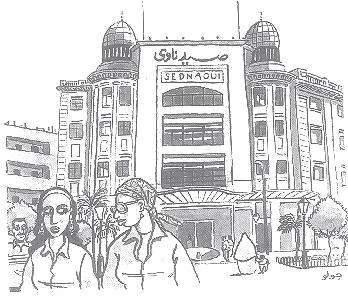SEDNAOUI
by Samir Raafat
Cairo Times, Thursday, 29 May 1997
extended version in "The Egyptian Bourse" published by Zeitouna 2010

|
|
|
|
|
Cheers to our "talented" literature prize awardee. Your pain his gain !!!
|
|
|
EGY.COM - LANDMARKS - CAIRO - HELIOPOLIS
|
|
by Samir Raafat
Cairo Times, Thursday, 29 May 1997
extended version in "The Egyptian Bourse" published by Zeitouna 2010

The odd man out among Cairo's department stores was Sednaoui. While most other stores belonged to Jews the owners of Sednaoui were Nazarenes from the Syrian villages of Sednaya and Maaloula where Aramaic was spoken until very recently. Newly arrived in Egypt by way of Damascus, the Sednaoui brothers, Samaan and Selim opened their first haberdashery late last century in the district of Hamzaoui before moving to Mousky Street in al-Azhar.
The brothers' fortune took a turn for the better when employees of the Khedivial harem had either overpaid or forgotten to take back the correct change. When khawaga Samaan ran after them pointing out what happened, the much obliged shoppers returned to the palace and related their exceptional encounter with an honest Shami (Syrian). From that day onwards Sednaoui was a favorite among the court ladies.
As Cairo expanded into the new European quarter of Ismailia, so did the city's great retailing names: Chemla, Cicurel and Ades were clustered on or near Avenue Fouad (26th of July), considered by many as Cairo's Oxford Street. Orosdi-Back (Omar Effendi) was within walking distance on Sharia AbdelAziz. Tiring, Stein and Morums had already opened on Attaba Square, the nexus of Cairo's commercial hub.
The Sednaoui brothers kept their distance from the rest of the department stores setting up shop in the more confined Place Khazindar. It was there on 4 November 1913, in the presence of Prince Mohammed Ali Tewfik, that they inaugurated their grand three-story emporium near al-Bawaki, opposite the Services Club.
In no time Sednaoui at Khazindar became the flagship of their retail chain with branches in Alexandria, Port Said, Tantah, Mansourah, Fayoum and Assiout. And in keeping with time and a rising demand for their wares the department store's flagship was considerably revamped and enlarged with much celebration taking place in May 1925 at the re-opening.
In view of its classical fin de siècle architecture, Sednaoui could have been transplanted from any one of the great European capitals. In his quest to emulate Galleries Lafayette on Boulevard Hausmann in Paris, architect George Parcq spared nothing in terms of layout, metalwork, and general amenities. Even the flag flying cupolas were there. Yet it was no secret that Sednaoui played second fiddle to the classier Cicurel.
While Cicurel set the trends of consumer culture in Cairo, Sednaoui was not too far behind. And if the handsome and formidably attired Tcherkess guards flanked Cicurel's grand entrance on Avenue Fouad (later 26th of July), the Cairo ladies were extremely flattered whenever Monsieur Sednaoui greeted them personally as they marched through the portals of his emporium. Something which he did fairly regularly.
The clever merchant-turned-Bey and Papal Count in view of his extensive charities, promoted the idea that any "Sit" (woman) who bought from Sednaoui was a "Hanem" (lady). Sednaoui recalled only too well how the enunciation's of a woman could influence shopping habits citywide.
Samaan Sednaoui or one of his heirs were always there before the store opened to the public scanning the arrival of their well-mannered dandified male and female employees, inspecting them as they drifted to their stations. Once all was in shipshape the store opened for business.
As they entered Sednaoui, shoppers were immediately taken in by the grandiose atrium. Once inside, they would gape at the jewelry and cosmetic counters while the more courageous would try out the latest Parisian hats and accessories. Men, too, stopped at Sednaouis purchasing rolls of imported English cloth or Far Eastern fabrics for their wives or sweethearts. Sednaoui's was also the preferred lieu for a fleeting flirt because of its multiple entrances which formed perfect getaways.
And there was also the toy department where the wide eyed kiddies thought they had discovered heaven.
Masters of the retail universe, the Sednaouis made it seem like there was a special event each day of the year. Everything could be bought on account. Through their extensive purchasing agents in Paris, London and New York and with the assistance of Sednaoui Shipping Co. Ltd. of Princess Street, Manchester (later, Selfridges, London ), nothing was beyond Sednaoui's reach. Catalogues burst with seasonal buys whether for Xmas, Easter, Bairam or Back-to-school.
There were also those popular annual low-end sales! These were anticipated by the modest and lower middle income shoppers who, intimidated by Cicurel's sophistication, showed up boldly at Place Khazindar armed with the one-page newspaper ad listing the various Sednaoui discounts. For some it would be their only exposure ever to an in-store fashion show, an auction, Santa Claus or Xmas' in July!
For the big spenders, shopping at Sednaoui was more for pleasure than satisfying basic needs. On certain Sundays in the upper '50s, when the rest of commercial Cairo was shut down, Sednaoui opened by special arrangement to accommodate wealthy shop-till-you-drop clients from the Gulf. These arrived by the planeload with an extra one in reserve for the fully laden return trip.
In July 1961, Egypt's major department stores were nationalized wholesale. Mr. Elie Sednaoui, the then-director of S&S Sednaoui et Fils, was given an indefinite leave of absence. An army officer had come to replace him!
The age of drab counters and khaki colored cooperatives was about to begin.
|
|
|
|